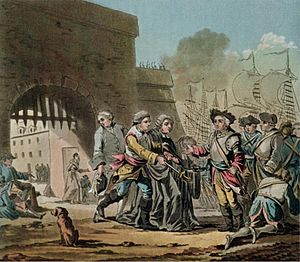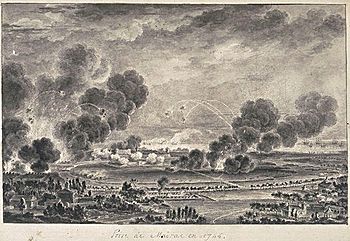Battle of Madras facts for kids
Quick facts for kids Battle of Madras |
|||||||
|---|---|---|---|---|---|---|---|
| Part of War of the Austrian Succession | |||||||
 Surrender of The City of Madras 1746, by Jacques François Joseph Swebach-Desfontaines |
|||||||
|
|||||||
| Belligerents | |||||||
| Commanders and leaders | |||||||
| Strength | |||||||
| 300 | |||||||
The Battle of Madras (also known as the Fall of Madras) took place in September 1746. During this battle, a French army attacked and captured the city of Madras from its British defenders. Madras was an important city in India, controlled by the British at the time. This event was part of a bigger conflict called the War of the Austrian Succession.
The French forces stayed in Madras until the war ended. Later, Madras was given back to the British. In return, the British gave back Louisbourg, a place they had captured in North America. This exchange was part of a peace agreement called the Treaty of Aix-la-Chapelle. A famous British defender named Robert Clive became well-known after he escaped from the French and told his leaders at Fort St David that Madras had fallen.
Contents
Why the Battle Happened
Since the 1720s, Britain and France were competing for control in India. This competition grew stronger over time. When France joined the War of the Austrian Succession against Britain, the British sent their navy to India. This navy, led by Commodore Curtis Barnett, attacked French ships and businesses in 1745. This caused problems for French traders.
To respond, France sent its own fleet, led by Bertrand-François Mahé de La Bourdonnais. After a battle that didn't have a clear winner, both fleets went to repair their ships. The British went to Ceylon (now Sri Lanka), and the French used their base at Pondicherry. The British commander, Edward Peyton, decided to avoid another big sea battle. He moved his ships to Bengal, leaving British settlements on the Coramandel coast unprotected from the French.
The French Governor of Pondicherry, Joseph François Dupleix, then decided to attack Madras. To get support from local Indian leaders, he promised the Nawab of the Carnatic (a powerful Indian ruler) that he would give Madras to him after capturing it from the British.
The Attack on Madras
On September 7, 1746, the people of Madras woke up to see a French fleet offshore. French soldiers were also landing on the beach. The French ships started firing at the town. At first, their shots didn't hit much, and many British defenders felt too safe.
The next morning, the French started firing again from both land and sea. This time, their aim was much better. Madras's defenses were not very strong and couldn't hold up against the attack. As more British soldiers were hurt, their courage and order broke down. After a direct hit on the liquor stores, some soldiers left their posts and became unable to fight. Civilians from the town tried to help defend, but it was clear that resistance was failing.
Surrender and Aftermath

On September 9, the Governor of Madras, Nicholas Morse, asked for peace. The French commander, La Bourdonnais, offered surprisingly fair terms. The French would take control of the fort and warehouses, but the rest of the town would stay under British control. The British soldiers who surrendered would be allowed to leave.
This agreement caused an argument between La Bourdonnais and his boss, Joseph François Dupleix. Dupleix wanted France to take complete control of Madras. But La Bourdonnais insisted on keeping his promise. For a month, the peace agreement he signed was followed.
However, a strong storm hit in October. La Bourdonnais and his fleet had to leave and sail to the safety of Pondicherry. A third of his ships were lost in the storm. Now, Dupleix was fully in charge of Madras. Dupleix then canceled the generous peace terms. He locked up many of the British soldiers and civilians. He also started to loot and prepare to destroy Fort St George.
A few of these prisoners, including a young clerk named Robert Clive, managed to escape. They dressed like local people and slipped out of their prison. Outside, they were challenged by real Indians who spoke languages they didn't understand. Clive and his friends quickly moved on before they could be caught. After a three-day journey, mostly at night, they reached Fort St David, which was a hundred miles away. They brought the news of the French attack on Madras. This escape was the first time Robert Clive gained wider attention.
What Happened Next
The French occupied Madras for the rest of the war. Dupleix had promised the Nawab of the Carnatic that he would hand over the territory. However, Dupleix refused to do so. The Nawab sent an army of 10,000 soldiers to make Dupleix keep his promise. But a small French force, led by Captain Louis Paradis, defeated them at the battle of Adyar on October 24, 1746. The French then tried to capture Fort St David but faced much stronger resistance and eventually had to retreat.
The Treaty of Aix-la-Chapelle, which ended the war, decided that Madras would be returned to the British. In exchange, the British gave back Louisbourg in Acadia, which they had captured in 1745. The French later attacked Madras again in 1759, but they were not successful that time.
See also

